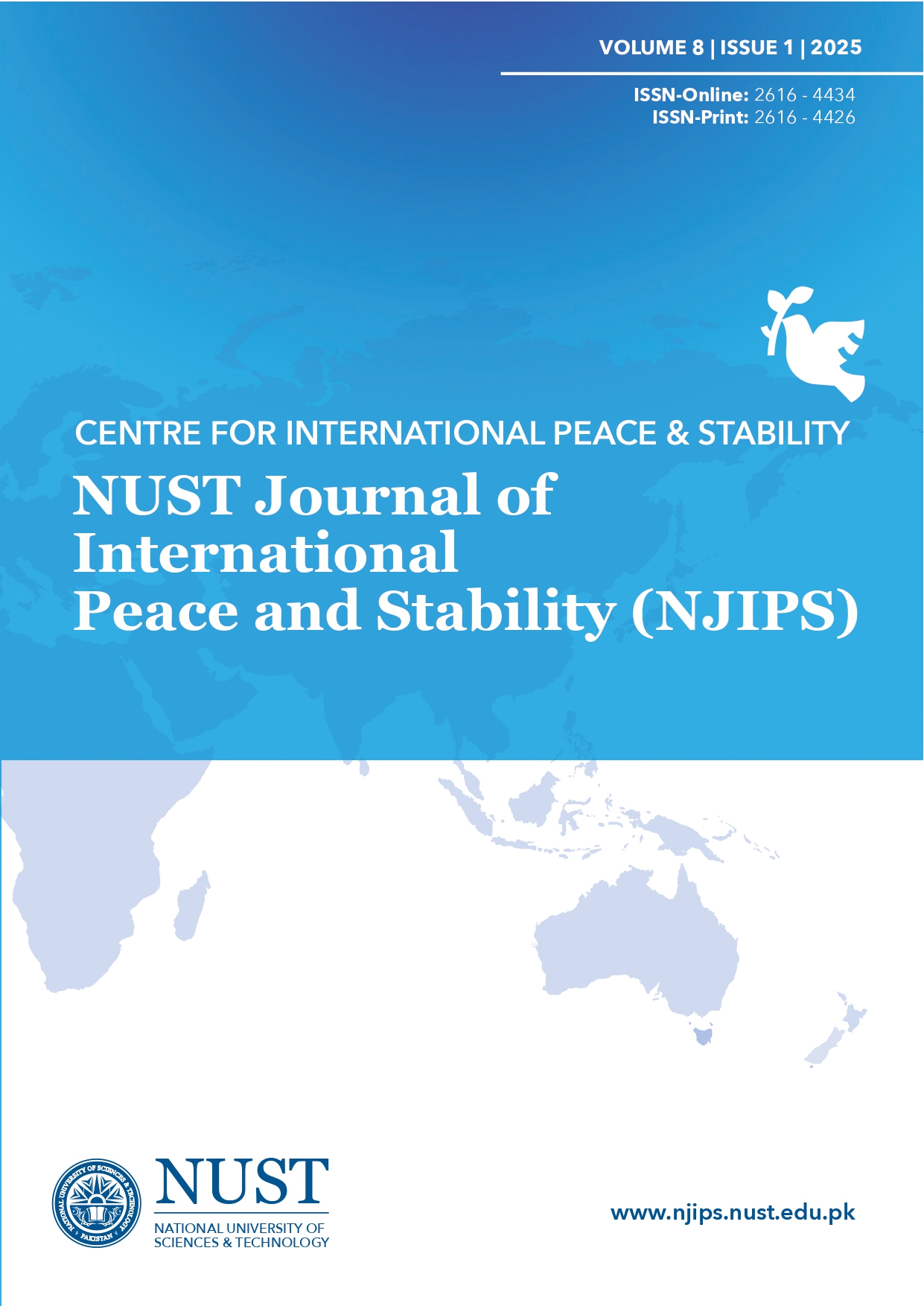Reevaluating Conventional Strategies: Harnessing Traditional Structures to Counter Violent Extremism in Pakistan
DOI:
https://doi.org/10.37540/njips.v8i1.186Keywords:
Traditional Structures, counter violent extremism, Jirga, Lashkar, counterinsurgency, PashtunwaliAbstract
Civil-military relations constitute a complex area of international relations through the interaction of military institutions, civil society, and other governmental bureaucracies. Civil-military relations investigate the dynamics of engagement between the military and the general public, as well as the obligation of society to scrutinize the foreign and military strategies of the government. Traditional structures, including informal associations, ethical standards, and communal conventions, have played a pivotal role in Pakistan’s efforts to quell violent insurgencies. These structures have substantially contributed to effectively eliminating extremist ideologies in cooperation with the military. The article explores the significance of a collaborative partnership between traditional structures and military organizations in combating insurgency and, ultimately, successfully eliminating terrorism. Three fundamental groups compose the traditional political system in Pakistan: the Jirga, the Lashkar, and the Clergy. Since 2012, this structure has been employed by the military across multiple tiers to suppress insurgencies, predominantly in the FATA, Swat region, Dir, and other districts where the authority of the state is at risk. The strategic alliance between the military and traditional structures is critical for combating insurgency.
References
Ahmad, N., Ali, S. R., & Bangash, A. K. (2020). The Role of Anti-Taliban Lashkar (Armed Militia) In Prevention of Terrorism in Conflict Affected Areas. Pakistan Journal of Society, Education and Language (PJSEL), 6(1), 94-102.
Afzal, M. (2021, January 15). Terrorism in Pakistan has declined, but the underlying roots of extremism remain. Brookings. https://www.brookings.edu/articles/terrorism-in-pakistan-has-declined-but-the-underlying-roots-of-extremism-remain/
Ahmed, S. (2016, November 9). A Twenty-Point Recipe of Peace – The National Action Plan for Pakistan: Context, Analysis and Evaluation of Successes and Pitfalls.
Akhtar, S., & Ahmed, Z. S. (2023). Understanding the resurgence of the Tehrik-e-Taliban Pakistan. Dynamics of Asymmetric Conflict, 16(3), 285-306. https://doi.org/10.1080/17467586.2023.2280924
Akram, N., & Tariq, K. (2024). War on Terrorism in Pakistan: Security Challenges and Safety Prioritization. Social Science and Humanities Journal (SSHJ), 8(04), 34765-34782.
Ali, A. (2013). Peace Talks with the Pakistani Taliban: Challenges and Prospects. Counter Terrorist Trends and Analyses, 5(4), 11-13.
Ali, I. (2018). Mainstreaming Pakistan’s federally administered tribal areas. United States Institute of Peace. https://www.jstor.org/stable/pdf/resrep17670.pdf
Benson, B., & Siddiqui, Z. (2014). Pashtunwali—Law for the lawless, defense for the
stateless. International Review of Law and Economics, 37, 108-120. https://doi.org/10.1016/j.irle.2013.07.008
Boone, J. (2012). Malala Yousafzai: 'fatwa' issued against gunmen. The Guardian.
https://www.theguardian.com/world/2012/oct/12/malala-yousafzai-fatwa-gunmen-pakistan
Desch, M. C. (1998). Soldiers, States, and Structures: The End of the Cold War and Weakening U.S. Civilian Control. Armed Forces & Society, 24(3), 389-405.
Galula, D. (2006). Counterinsurgency Warfare: Theory and Practice. Bloomsbury Publishing USA.
Hansen, S. J. (2024). Mosaic; counter-insurgency approaches and the war against the Islamic state in Mozambique. Small Wars & Insurgencies, 1-31. https://doi.org/10.1080/09592318.2024.2417134
Irfan, A., Khan, A. W., & Naqvi, A. (2022). Counter-terrorism strategy of Pakistan: A case study of military operations. Journal of Development and Social Sciences, 3(3), 843-855.
Iqbal, S., & Alam, I. (2020). The Role of Traditional Elders in the Establishment of
the Law and Order in FATA, Pakistan. Al-Idah, 38(1), Article 1. https://doi.org/10.37556/al-idah.038.01.0348
Jacobs, W. D. (1964). Review of Review of Counter-Insurgency Warfare: Theory and Practice.; The Military in the Political Development of New Nations: An Essay in Comparative Analysis., by D. Galula & M. Janowitz. The Journal of Politics, 26(4), 954-956. https://doi.org/10.2307/2128251
Joh, E. E. (2000). Custom, tribal court practice, and popular justice. American Indian Law Review, 25(1), 117-132.
Khan, A., Qasim, M., Khan, W. U., Wasif, M., & Khan, K. (2023). A Comprehensive Examination of The Efficacy of Narrative Constructs as a Countermeasure Against Violent Extremism. Russian Law Journal, 11(1), 194-206
Khan, S., Wazir, T., & Khan, A. (2019). The Effects of Militancy and Military Operations on Pashtun Culture and Traditions in FATA. Liberal Arts and Social Sciences International Journal (LASSIJ), 3(1), Article 1. https://doi.org/10.47264/idea.lassij/3.1.7
Khokhar, I., Kamran, S., Abbasi, M. A., & Jafar, G. (Eds.). (2014). Evolving
Dynamics of FATA: Reflections on Transformations. National Defence University.
Nawaz, S. (2011). Learning by Doing. Atlantic Council.
https://ciaotest.cc.columbia.edu/wps/atlanticco/0031804/f_0031804_25814.pdf
Otero-Bahamon, S., Uribe, S., & Peñaranda-Currie, I. (2022). Seeing like a guerrilla:
The logic of infrastructure in the building of insurgent orders. Geoforum, 133, 198-207.
Perlez, J., & Shah, P. Z. (2008, October 23). Pakistan Uses Tribal Militias in Taliban War. The New York Times. https://www.nytimes.com/2008/10/24/world/asia/24militia.html
Pakistan Army Launches “Operation Radd-ul-Fasaad” across the country. (2017, February 22). Dawn. http://www.dawn.com/news/1316332
Reeder, B. (2016). [Summary of Counterinsurgency Warfare: Theory and Practice, Praeger Security International by David Galula, Beyond Intractability. https://www.beyondintractability.org/bksum/galula-counterinsurgency
Sanaullah., Gul, B., & Hassan, M. (2021). Terrorism and Counter-Terrorism
Strategies: A Case Study of Pakistan with Special Reference to National Action Plan. Global Strategic & Security Studies Review, VI(II), 84-95. https://doi.org/10.31703/gsssr.2021(VI-II).09
SATP (n.d.). Terrorism in Pakistan―Yearly Fatalities.
https://www.satp.org/datasheet-terroristattack/fatalities/pakistan
Sultan, N., Rehman, A. U., Khan, A. N., & Tanvir, R. (2024). Pakistan’s Military
Operations in Erstwhile Fata and De-Radicalization Process in Education Sector After 2014. Pakistan Journal of Law, Analysis and Wisdom, 3(1), 194-206
Spee, J. C., McMurray, A., & McMillan, M. (Eds.). (2021). Clan and tribal
perspectives on social, economic and environmental sustainability: Indigenous stories from around the globe. Emerald Publishing Limited. https://www.emerald.com/insight/content/doi/10.1108/978-1-78973-365-520211001/full/html
Vision of Humanity (2023). Global Terrorism Index – 2023.
https://www.visionofhumanity.org/maps/globalterrorism-index/
Vrooman, S. (2005a). A Counterinsurgency Campaign Plan Concept: The Galula
Compass. p. 8-16. Defense Technical Information Center. https://doi.org/10.21236/ADA436240
Vrooman, S. (2005b). A Counterinsurgency Campaign Plan Concept: The Galula
Compass. Defense Technical Information Center. https://doi.org/10.21236/ADA436240
Yamin, T. (2019). Civil-Military Relation and Stabilization in Federally Administered
Tribal Areas (FATA), Pakistan. NUST Journal of International Peace & Stability, 2(2). https://doi.org/10.37540/njips.v2i2.35
Yousaf, F. (2020). Pakistan, Regional Security and Conflict Resolution: The Pashtun
‘Tribal ‘Areas. Routledge.
Yousaf, F., & FurrukhZad, S. (2020). Pashtun Jirga and prospects of peace and
conflict resolution in Pakistan’s ‘tribal’ frontier. Third World Quarterly, 41(7), 1200-1217. https://doi.org/10.1080/01436597.2020.1760088
Downloads
Published
How to Cite
License
Copyright (c) 2025 NUST Journal of International Peace & Stability

This work is licensed under a Creative Commons Attribution-NonCommercial 4.0 International License.

1.png)

